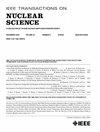A Novel Gap-Fin Design of Rotating Scatter Mask Collimator for Radiation Source Localization
IF 1.9
3区 工程技术
Q3 ENGINEERING, ELECTRICAL & ELECTRONIC
引用次数: 0
Abstract
Compared to directional radiation detection equipment, such as the gamma camera, the solution with a non-directional radiation sensor and a collimator has a lower cost and is applicable in scenes with strong radiation. Since the collimator can greatly improve the sensor’s ability to identify the direction of radiation sources, the collimator design is extremely important. In this article, aiming to address the misidentification problem of the existing Wall-Fin rotating scatter mask (RSM) collimator, a novel design (Gap-Fin) is proposed based on the optimized detector response curve (DRC). A model optimization method based on key parameters is proposed and quantitatively verified through simulations with Geant4. Simulations are also conducted to compare the optimized Gap-Fin design with the original design in scenarios with one and two sources, where different detection distances, particle energies, particle numbers, and shielding materials are used. Simulation results show that the optimized Gap-Fin design has better detection accuracy and anti-interference ability. In addition, the optimized collimator is applied to locate the radiation source both in simulation and a robot detection experiment, which shows the effectiveness of the novel collimator design in radiation source localization.一种用于辐射源定位的旋转散射掩模准直器的缝隙-翅片设计
与伽马相机等定向辐射检测设备相比,采用非定向辐射传感器和准直仪的解决方案成本更低,适用于强辐射场景。由于准直器可以大大提高传感器对辐射源方向的识别能力,因此准直器的设计非常重要。针对现有壁面-翅片旋转散射掩模准直器存在的误识别问题,提出了一种基于优化的探测器响应曲线(DRC)的新型设计(Gap-Fin)。提出了一种基于关键参数的模型优化方法,并通过Geant4仿真进行了定量验证。在不同探测距离、粒子能量、粒子数和屏蔽材料的情况下,对优化后的Gap-Fin设计与原设计进行了仿真比较。仿真结果表明,优化后的Gap-Fin具有更好的检测精度和抗干扰能力。此外,将优化后的准直器应用于仿真和机器人检测实验中,验证了该准直器在辐射源定位中的有效性。
本文章由计算机程序翻译,如有差异,请以英文原文为准。
求助全文
约1分钟内获得全文
求助全文
来源期刊

IEEE Transactions on Nuclear Science
工程技术-工程:电子与电气
CiteScore
3.70
自引率
27.80%
发文量
314
审稿时长
6.2 months
期刊介绍:
The IEEE Transactions on Nuclear Science is a publication of the IEEE Nuclear and Plasma Sciences Society. It is viewed as the primary source of technical information in many of the areas it covers. As judged by JCR impact factor, TNS consistently ranks in the top five journals in the category of Nuclear Science & Technology. It has one of the higher immediacy indices, indicating that the information it publishes is viewed as timely, and has a relatively long citation half-life, indicating that the published information also is viewed as valuable for a number of years.
The IEEE Transactions on Nuclear Science is published bimonthly. Its scope includes all aspects of the theory and application of nuclear science and engineering. It focuses on instrumentation for the detection and measurement of ionizing radiation; particle accelerators and their controls; nuclear medicine and its application; effects of radiation on materials, components, and systems; reactor instrumentation and controls; and measurement of radiation in space.
 求助内容:
求助内容: 应助结果提醒方式:
应助结果提醒方式:


